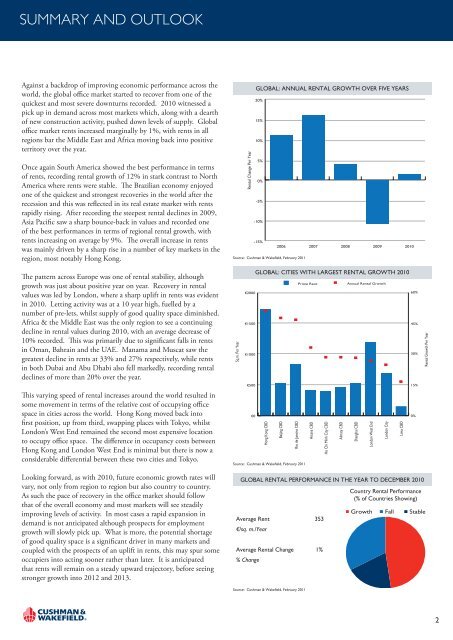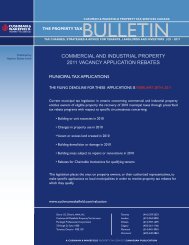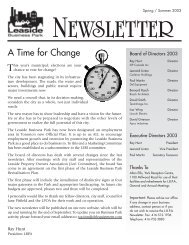Office Space Across the World 2011 - Bayleys
Office Space Across the World 2011 - Bayleys
Office Space Across the World 2011 - Bayleys
You also want an ePaper? Increase the reach of your titles
YUMPU automatically turns print PDFs into web optimized ePapers that Google loves.
SUMMARY AND OUTLOOK<br />
Against a backdrop of improving economic performance across <strong>the</strong><br />
world, <strong>the</strong> global office market started to recover from one of <strong>the</strong><br />
quickest and most severe downturns recorded. 2010 witnessed a<br />
pick up in demand across most markets which, along with a dearth<br />
of new construction activity, pushed down levels of supply. Global<br />
office market rents increased marginally by 1%, with rents in all<br />
regions bar <strong>the</strong> Middle East and Africa moving back into positive<br />
territory over <strong>the</strong> year.<br />
Once again South America showed <strong>the</strong> best performance in terms<br />
of rents, recording rental growth of 12% in stark contrast to North<br />
America where rents were stable. The Brazilian economy enjoyed<br />
one of <strong>the</strong> quickest and strongest recoveries in <strong>the</strong> world after <strong>the</strong><br />
recession and this was reflected in its real estate market with rents<br />
rapidly rising. After recording <strong>the</strong> steepest rental declines in 2009,<br />
Asia Pacific saw a sharp bounce-back in values and recorded one<br />
of <strong>the</strong> best performances in terms of regional rental growth, with<br />
rents increasing on average by 9%. The overall increase in rents<br />
was mainly driven by a sharp rise in a number of key markets in <strong>the</strong><br />
region, most notably Hong Kong.<br />
The pattern across Europe was one of rental stability, although<br />
growth was just about positive year on year. Recovery in rental<br />
values was led by London, where a sharp uplift in rents was evident<br />
in 2010. Letting activity was at a 10 year high, fuelled by a<br />
number of pre-lets, whilst supply of good quality space diminished.<br />
Africa & <strong>the</strong> Middle East was <strong>the</strong> only region to see a continuing<br />
decline in rental values during 2010, with an average decrease of<br />
10% recorded. This was primarily due to significant falls in rents<br />
in Oman, Bahrain and <strong>the</strong> UAE. Manama and Muscat saw <strong>the</strong><br />
greatest decline in rents at 33% and 27% respectively, while rents<br />
in both Dubai and Abu Dhabi also fell markedly, recording rental<br />
declines of more than 20% over <strong>the</strong> year.<br />
This varying speed of rental increases around <strong>the</strong> world resulted in<br />
some movement in terms of <strong>the</strong> relative cost of occupying office<br />
space in cities across <strong>the</strong> world. Hong Kong moved back into<br />
first position, up from third, swapping places with Tokyo, whilst<br />
London’s West End remained <strong>the</strong> second most expensive location<br />
to occupy office space. The difference in occupancy costs between<br />
Hong Kong and London West End is minimal but <strong>the</strong>re is now a<br />
considerable differential between <strong>the</strong>se two cities and Tokyo.<br />
Looking forward, as with 2010, future economic growth rates will<br />
vary, not only from region to region but also country to country.<br />
As such <strong>the</strong> pace of recovery in <strong>the</strong> office market should follow<br />
that of <strong>the</strong> overall economy and most markets will see steadily<br />
improving levels of activity. In most cases a rapid expansion in<br />
demand is not anticipated although prospects for employment<br />
growth will slowly pick up. What is more, <strong>the</strong> potential shortage<br />
of good quality space is a significant driver in many markets and<br />
coupled with <strong>the</strong> prospects of an uplift in rents, this may spur some<br />
occupiers into acting sooner ra<strong>the</strong>r than later. It is anticipated<br />
that rents will remain on a steady upward trajectory, before seeing<br />
stronger growth into 2012 and 2013.<br />
Sq.m. Per Year<br />
Rental Change Per Year<br />
€2000<br />
€1500<br />
€1000<br />
€500<br />
€0<br />
GLOBAL: ANNUAL RENTAL GROWTH OVER FIVE YEARS<br />
20%<br />
15%<br />
10%<br />
5%<br />
0%<br />
-5%<br />
-10%<br />
-15%<br />
GLOBAL: CITIES WITH LARGEST RENTAL GROWTH 2010<br />
Hong Kong CBD<br />
2006<br />
Source: Cushman & Wakefield, February <strong>2011</strong><br />
Beijing CBD<br />
Rio de Janeiro CBD<br />
Source: Cushman & Wakefield, February <strong>2011</strong><br />
2007<br />
Prime Rent<br />
Astana CBD<br />
Ho Chi Minh City CBD<br />
Almaty CBD<br />
Annual Rental Growth<br />
GLOBAL RENTAL PERFORMANCE IN THE YEAR TO DECEMBER 2010<br />
Average Rent 353<br />
€/sq. m./Year<br />
Average Rental Change 1%<br />
% Change<br />
Source: Cushman & Wakefield, February <strong>2011</strong><br />
2008<br />
Shanghai CBD<br />
London West End<br />
2009<br />
London City<br />
Lima CBD<br />
2010<br />
60%<br />
45%<br />
30%<br />
15%<br />
0%<br />
Country Rental Performance<br />
(% of Countries Showing)<br />
Growth<br />
Fall Stable<br />
Rental Growth Per Year<br />
2





